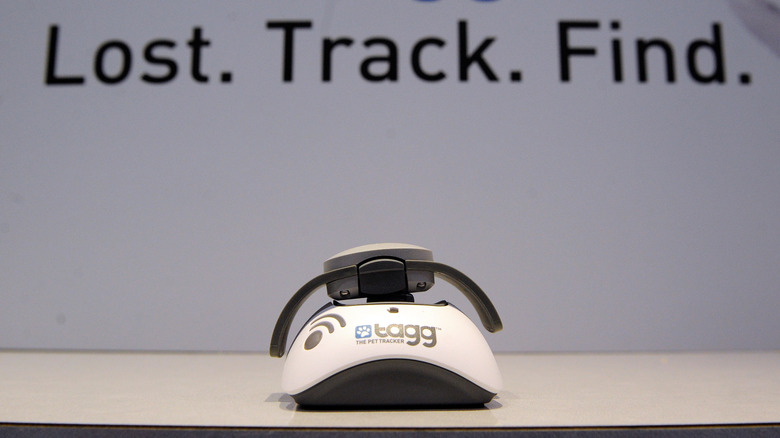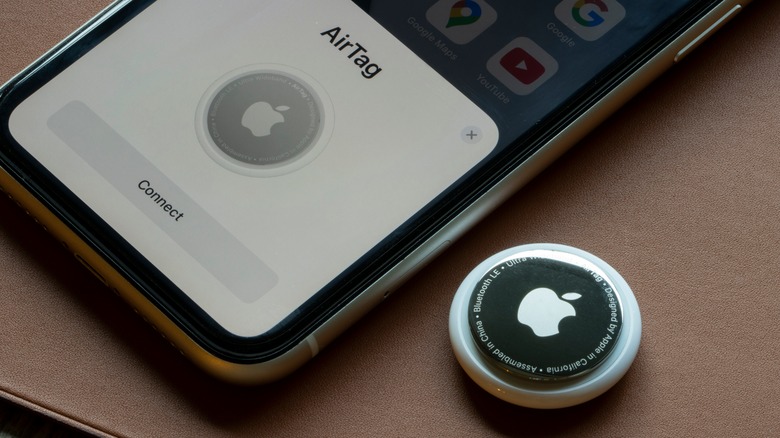How Do Pet Trackers Work? Can You Use An AirTag Instead?
While some pets never really venture anywhere, others, like some cats, take more of a wherever-I-lay-my-hat approach to life. In the course of a given night, they could have roamed anywhere. Concerned owners might consider a pet tracker to help alleviate some of this worry, particularly with the ending of T-Mobile's SyncUP Pets service in November 2023.
Those new to such products are surely curious about how exactly a pet tracker works and why they're a separate genre of tracker to the likes of an AirTag. Here's how these pet-specific devices work, as well as the differences between them and the ones you'd attach to your luggage before heading to the airport.
GPS trackers come in various shapes and sizes, and so do those developed specifically for keeping track of pets. Typically small, unobtrusive, and conveniently able to clip to a collar, they use different types of technology. The best type, as is always the case with any device, is the one that fits your specific needs and requirements.
The technology behind pet trackers
An adventurous pet that journeys further away, like a rural cat, may not be very well served by a Bluetooth tracker, as their effective range is generally limited to about 200 feet. These trackers are convenient to pair with an app, but as always with Bluetooth, the wide compatibility is tempered by the limited distance possible between the paired devices.
Other pet trackers utilize cell signals in tandem with those from satellites. The GPS device beams your pet's location through the satellites and to your smart device, revealing your loveable companion's location. Such trackers have a considerably greater range, utilizing satellite technology (and potentially Wi-Fi too). The issue is that results are only available via quality coverage: In January 2023, Statista reported that T-Mobile's 54% U.S. 5G share was the nation's largest, indicative of the fact that consistent GPS signals can be difficult to come by. If your connection is even spotty, you won't get precise results. With such trackers, precision is crucial.
Radio frequencies are also utilized in some pet trackers. A different duo of devices are paired in these cases: a small label and a remote tracker. Holding the latter, the user is pointed toward their pet by the readings, which will be stronger when pointed toward the pet's label. In busy neighborhoods and such areas, though, the signal will be limited, and the lack of a handy map app showing your pet's location is a huge disadvantage.
Why not just use an AirTag?
Typically, the receiver for a pet tracker is small and discreet, helping to keep your pet safe without weighing them down or restricting their movement. The likes of a Tile or AirTag share these traits. As such, you may be tempted to simply clip an AirTag or similar to their collar/leash/harness. While you certainly can, the results might not be what you hoped for.
AirTags are invaluable for travelers, who may need the reassurance that their baggage has arrived in the country with them. There's a reason, though, that Apple Support states that AirTags are for locating "personal items" rather than pets or people.
The primary problem is that pet trackers transmit information only between your device and your pet's (satellites notwithstanding). AirTags, by contrast, offer location information when they've been able to triangulate it through another iPhone. Quieter, rural locations may not make such a connection for a long time, if ever. To compound the problem, PitPat tested AirTag connections in a busy dog walking area and noted that "it was taking up to 15 minutes from the time of the fix for it to be reported on our own iPhone."
When pets are lost, time is of the essence, and real-time location information can be crucial. AirTags, unfortunately, can't be relied upon to provide this, and so aren't intended to serve the purpose. Dedicated pet trackers are highly recommended instead.


